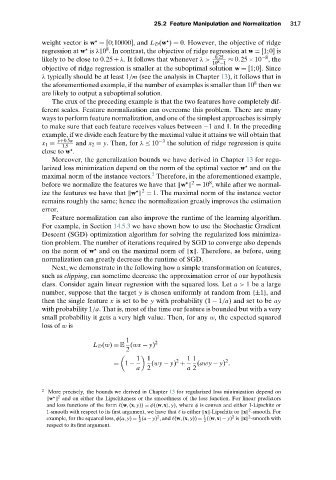Page 335 - Understanding Machine Learning
P. 335
25.2 Feature Manipulation and Normalization 317
weight vector is w = [0;10000], and L D (w ) = 0. However, the objective of ridge
8
regression at w is λ10 . In contrast, the objective of ridge regression at w = [1;0] is
−8
likely to be close to 0.25 + λ. It follows that whenever λ> 0.25 ≈ 0.25 × 10 ,the
8
10 −1
objective of ridge regression is smaller at the suboptimal solution w = [1;0]. Since
λ typically should be at least 1/m (see the analysis in Chapter 13), it follows that in
8
the aforementioned example, if the number of examples is smaller than 10 then we
are likely to output a suboptimal solution.
The crux of the preceding example is that the two features have completely dif-
ferent scales. Feature normalization can overcome this problem. There are many
ways to perform feature normalization, and one of the simplest approaches is simply
to make sure that each feature receives values between −1 and 1. In the preceding
example, if we divide each feature by the maximal value it attains we will obtain that
y+0.5α −3
x 1 = and x 2 = y. Then, for λ ≤ 10 the solution of ridge regression is quite
1.5
close to w .
Moreover, the generalization bounds we have derived in Chapter 13 for regu-
larized loss minimization depend on the norm of the optimal vector w andonthe
2
maximal norm of the instance vectors. Therefore, in the aforementioned example,
2
8
before we normalize the features we have that w = 10 , while after we normal-
2
ize the features we have that w = 1. The maximal norm of the instance vector
remains roughly the same; hence the normalization greatly improves the estimation
error.
Feature normalization can also improve the runtime of the learning algorithm.
For example, in Section 14.5.3 we have shown how to use the Stochastic Gradient
Descent (SGD) optimization algorithm for solving the regularized loss minimiza-
tion problem. The number of iterations required by SGD to converge also depends
on the norm of w and on the maximal norm of x . Therefore, as before, using
normalization can greatly decrease the runtime of SGD.
Next, we demonstrate in the following how a simple transformation on features,
such as clipping, can sometime decrease the approximation error of our hypothesis
class. Consider again linear regression with the squared loss. Let a > 1bealarge
number, suppose that the target y is chosen uniformly at random from {±1},and
then the single feature x is set to be y with probability (1 − 1/a)and set to be ay
with probability 1/a. That is, most of the time our feature is bounded but with a very
small probability it gets a very high value. Then, for any w, the expected squared
loss of w is
1 2
L D (w) = E (wx − y)
2
1 1 2 1 1 2
= 1 − (wy − y) + (awy − y) .
a 2 a 2
2 More precisely, the bounds we derived in Chapter 13 for regularized loss minimization depend on
2
w and on either the Lipschitzness or the smoothness of the loss function. For linear predictors
and loss functions of the form (w,(x, y)) = φ( w,x , y), where φ is convex and either 1-Lipschitz or
2
1-smooth with respect to its first argument, we have that is either x -Lipschitz or x -smooth. For
1
2
2
2
1
example, for the squared loss, φ(a, y) = (a − y) ,and (w,(x, y)) = ( w,x − y) is x -smooth with
2 2
respect to its first argument.

